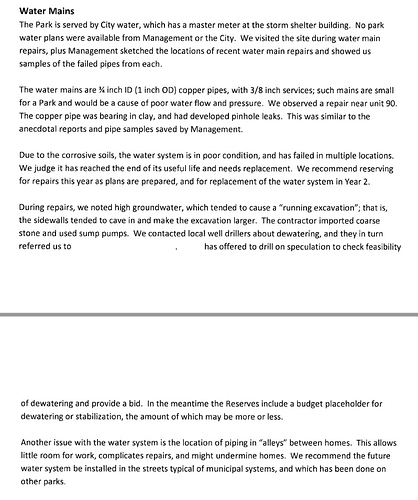Buying a park on city utilities in location with high water table. Park has been prone to leaks making r&m and excavation more challenging and expensive. Curious if anyone else has experienced multiple years of ownership in high water table area and how experience has been. I asked one excavator that’s worked on property if he had to quantify the additional labor/digging/equipment and he put at 2x normal.
Dewatering will certainly bump the price of any excavation work. What system are you having issues with?
If the community is on a septic system, the high water table will cause backups into septic tanks because the leach field can’t drain. Usually a mound system will be installed in this situation. If you are on city sewer, lining the sewer mains on the property should address the leaks, but I doubt you are being charged for sewer flow. If the water main is leaking, that is not usually a high water table issue.
Thanks for your response.
It’s on city water and sewer. Anecdotally there are no sewer issues. So main concern is difficulty around fixing water leaks in high water table area. Just sounds like it’s significantly more work involved when leaks do arise.
I ran a park for three years that had a high water table. We had leaks from old terracotta lines and also the park flooded from heavy rains (bigger problem). A new line can be built within the old failing line and holes can be patched with extremely fast solidifying polymers. These processes are not without their issues, but they avoid the need to excavate, which as you said can be an issue if there is a high water table.
I’m not sure I buy the 2x estimate. I could see 2x in a scenario where you have a failed sewer line and you have to pay a honey wagon by the hour to pump out the sewage while you dig and try to find a solution to groundwater that won’t recede to a level below your pipe.
Some further concerns here I was able to uncover (see pic). Namely pipe dimensions (85 lot park). This is in a harsh weather climate where I already operate. The one section with problematic leaks due to “corrosive” soils has already been fixed, but not sure I’ve dealt with copper sitting in clay generally before. I probably wouldn’t entertain this deal if I didn’t already have a significant presence in the area, but gauging risk (price) is proving to be more difficult.
Another strike - legacy heating fuel lines underground (now direct billed gas). Closure letter re: “petroleum tank release at site” was granted by the state 2015 but theoretically liability still exists and something new could arise.
Any thoughts here? Thanks!
@PhillipMerrill seems to be one of the pipe dimension wizards if I remember correctly 
3/4" main lines on a 85 space park is a disaster! It doesn’t seem like the information is correct. Double check. I operate the water system on a 34 space park with 80% 1" mainline, 20% 2" it is workable but only because the 2" portion was added to solve the low water pressure and a larger pump was added.
Copper or ductile laid on top of clay is going to be a perpetual problem (electrolysis) until you replace all of it with pvc mainline and pvc or pex laterals. The high water table only increases the rate of electrolysis.
Hope that helps
Incredibly helpful. Thank you!
